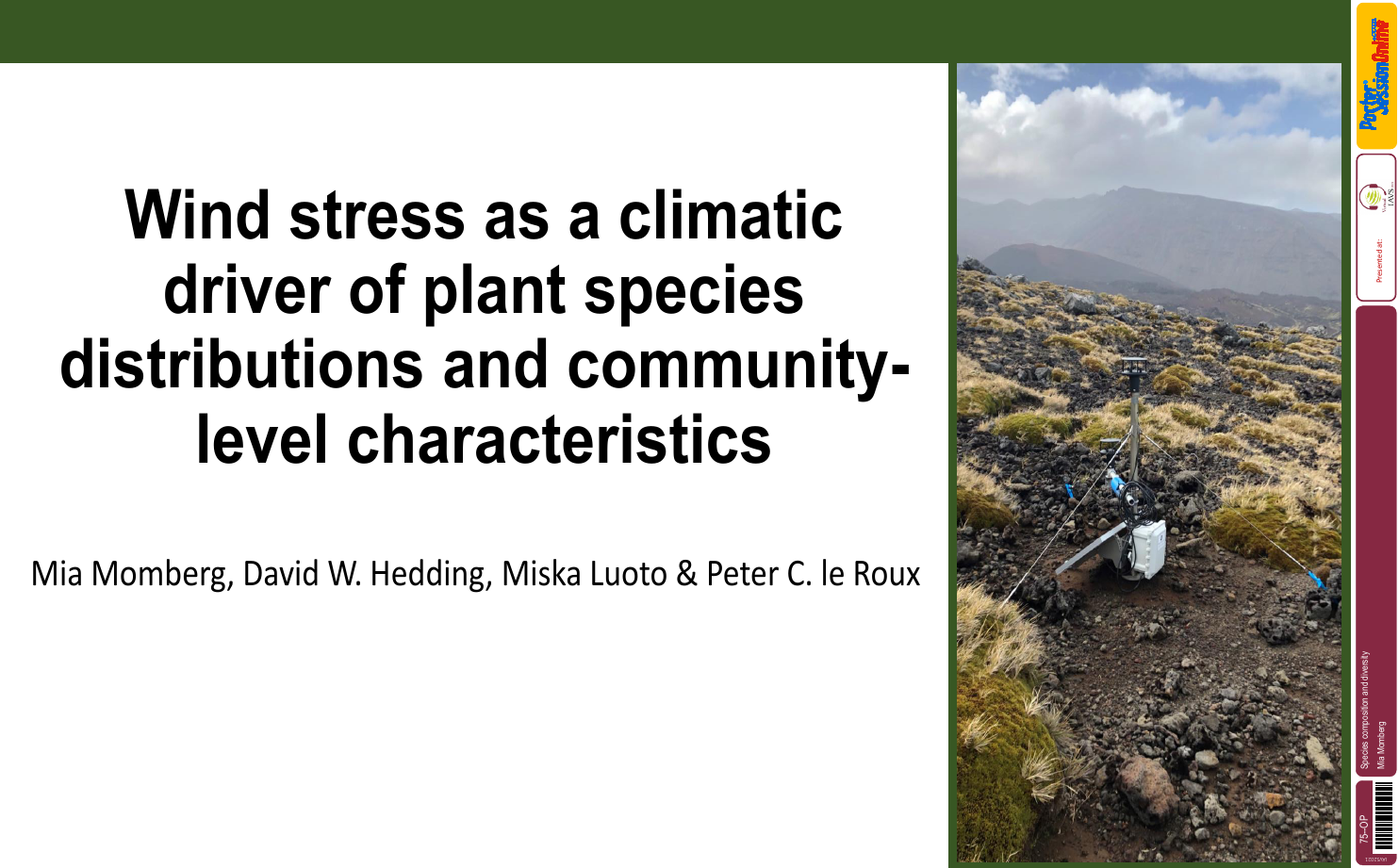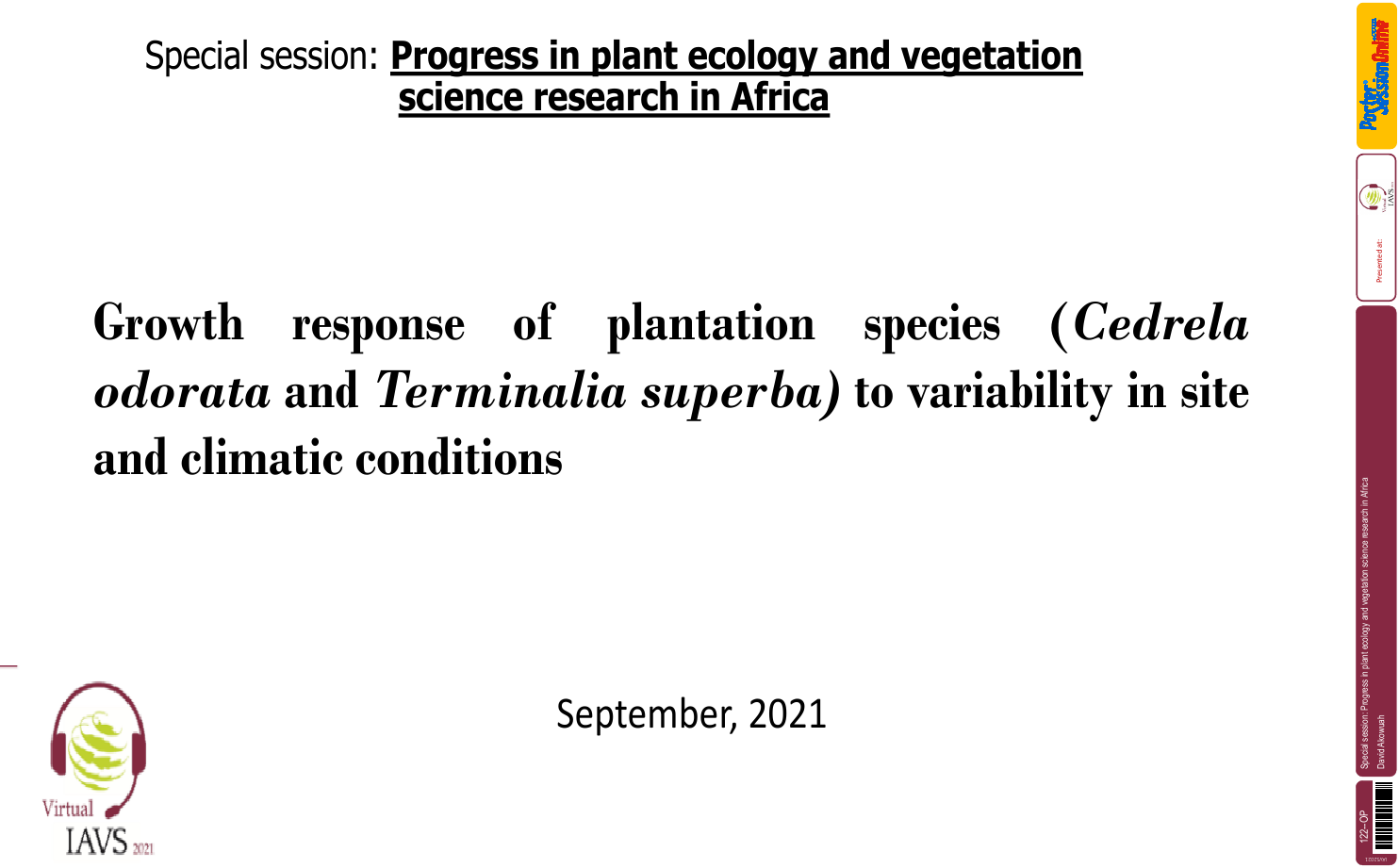| |
 |
|
 |
 |
 |

|
Poster: 75
Visits: 190
Title: Wind stress as a climatic driver of plant species distributions and community-level characteristics
Authors: Mia Momberg ,
Centre:
|
|
You must be registered to reply or comment.
|
|
WIND STRESS AS A CLIMATIC DRIVER OF PLANT SPECIES DISTRIBUTIONS AND COMMUNITY-LEVEL CHARACTERISTICS
|
 |  | Mia Momberg |
Thread initiator
Subspeciality
Reg: 9/8/2021 1:47:00 PM
|
 |
Comment# 1
|
I invite colleagues to open debate around the issues raised in my presentation, both those relating to research and to practice.
Comment added on 9/14/2021 10:25:00 AM
|
|
|
 |
| |
 |
|
 |  | Yi-Nuo Lee |
Subspeciality
Reg: 9/8/2021 7:52:00 PM
|
 |
Comment# 2
|
Hi,
Thank you for your talk that emphasizes on more attention should be put on the wind in the community-level study. I'd like to ask two questions: first, I have a question about the connection between the wind and climate change. I agree that adding the wind into the model could result in a better prediction of species distribution. But I wonder whether the climate change could also affect on the pattern of wind, like temperature and preciptation, especially in your study area. Second, do you have some observations of traits of the plants in the field that you think is related to the wind? According to some ecophysiological studies of the wind's effect (I offer them below, please consider it), it looks like that plant may use some strategies which is similar to mitigate the heat or drought stress. In this view, maybe the seperation of the effect of climate change from the effect of wind may be more difficult than imagination. Thank you.
Leigh, A., Sevanto, S., Ball, M.C., Close, J.D., Ellsworth, D.S., Knight, C.A. et al. (2012) Do thick leaves avoid thermal damage in critically low wind speeds? New Phytologist, 194, 477–487.
Iogna, P.A., Bucci, S.J., Scholz, F.G. and Goldstein, G. (2013) Homerstasis in leaf water potentials on leeward and windward sides of desert shrub crowns: water loss control vs. high hydraulic efficiency. Oecologia, 173, 675–687.
Comment added on 9/20/2021 7:00:00 PM
|
|
|
 |
| |
 |
|
 |  | Gerald Jurasinski |
Subspeciality
Reg: 9/20/2021 11:34:00 AM
|
 |
Comment# 3
|
Hi Mia,
very cool topic and nice talk. Interesting to see, that Peter is still working on Marion Island (pas myy greetings).
I have question, though: Wouldn't it be enough to include geomorphology directly as a variable since wind stress index is likely heavily influenced by the surface model, isn't it?
Best
Gerald
Comment added on 9/22/2021 8:22:00 AM
|
|
|
 |
| |
 |
|
 |  | Mia Momberg |
Thread initiator
Subspeciality
Reg: 9/8/2021 1:47:00 PM
|
 |
 |
|
Yi-Nuo Lee wrote on 20/09/2021 19:00:00
Hi,
Thank you for your talk that emphasizes on more attention should be put on the wind in the community-level study. I'd like to ask two questions: first, I have a question about the connection between the wind and climate change. I agree that adding the wind into the model could result in a better prediction of species distribution. But I wonder whether the climate change could also affect on the pattern of wind, like temperature and preciptation, especially in your study area. Second, do you have some observations of traits of the plants in the field that you think is related to the wind? According to some ecophysiological studies of the wind's effect (I offer them below, please consider it), it looks like that plant may use some strategies which is similar to mitigate the heat or drought stress. In this view, maybe the seperation of the effect of climate change from the effect of wind may be more difficult than imagination. Thank you.
Leigh, A., Sevanto, S., Ball, M.C., Close, J.D., Ellsworth, D.S., Knight, C.A. et al. (2012) Do thick leaves avoid thermal damage in critically low wind speeds? New Phytologist, 194, 477–487.
Iogna, P.A., Bucci, S.J., Scholz, F.G. and Goldstein, G. (2013) Homerstasis in leaf water potentials on leeward and windward sides of desert shrub crowns: water loss control vs. high hydraulic efficiency. Oecologia, 173, 675–687.
|
 |
 |
|
Comment# 4
|
Hi Yi-Nuo,
Thanks for your questions.
1. Yes, I think that climate change leading to changes in wind patterns will definitey have an impact on species and communities. So I think it is important that we quabtify the effects of wind at present so that we can make predictions for what will happen under future wind scenarios.
2. Thank you for the interseting reading recommendations. On Marion most of the plants are low-growing and I suspect that this trait is related to wind more than temperature or precipitation. But I agree that for some traits it can be difficult to disentangle the effects of wind and temperature/precipiration and, therefore, how species will react to changes in climate.
Comment added on 9/23/2021 8:00:00 PM
Quoting Yi-Nuo Lee
|
|
|
 |
| |
 |
|
 |  | Mia Momberg |
Thread initiator
Subspeciality
Reg: 9/8/2021 1:47:00 PM
|
 |
 |
|
Gerald Jurasinski wrote on 22/09/2021 8:22:00
Hi Mia,
very cool topic and nice talk. Interesting to see, that Peter is still working on Marion Island (pas myy greetings).
I have question, though: Wouldn't it be enough to include geomorphology directly as a variable since wind stress index is likely heavily influenced by the surface model, isn't it?
Best
Gerald
|
 |
 |
|
Comment# 5
|
Hi Gerald,
Thank you very much. I will give Peter your greetings.
In an environment where the wind comes from different directions and there is no dominant wind direction, I think that geomorphology, or more likely topigraphy, could be used directly with quite good results. You are right that the wind stress index is very dependant on topography. However, on Marion there is a very clear dominant wind direction, with almost all of the wind coming from one direction. So ij this case, it is important to include that into the calculation because it will affect which areas experience more or less wind (e,g behind a large rock will be shetered, but only on the leeward side of the dominant wind direction, whereas it will be very windy on the windward side). So I think what will be sufficient to include will depend on the general wind conditions ar your site. The other neat part of this wind stress index is that it also incorporates wind speed which can have a large impact on the stress the plants experience.
Best wishes,
Mia
Comment added on 9/23/2021 8:09:00 PM
Quoting Gerald Jurasinski
|
|
|
 |
| |
 |
|
 |  | Gerald Jurasinski |
Subspeciality
Reg: 9/20/2021 11:34:00 AM
|
 |
 |
|
Mia Momberg wrote on 23/09/2021 20:09:00
Hi Gerald,
Thank you very much. I will give Peter your greetings.
In an environment where the wind comes from different directions and there is no dominant wind direction, I think that geomorphology, or more likely topigraphy, could be used directly with quite good results. You are right that the wind stress index is very dependant on topography. However, on Marion there is a very clear dominant wind direction, with almost all of the wind coming from one direction. So ij this case, it is important to include that into the calculation because it will affect which areas experience more or less wind (e,g behind a large rock will be shetered, but only on the leeward side of the dominant wind direction, whereas it will be very windy on the windward side). So I think what will be sufficient to include will depend on the general wind conditions ar your site. The other neat part of this wind stress index is that it also incorporates wind speed which can have a large impact on the stress the plants experience.
Best wishes,
Mia
|
 |
 |
|
Comment# 6
|
Hi Mia,
thank you for your answer. Sounds reasonable. And of course, including wind speeds is another point in favor of the wind index.
I am living at the coast here in Germany and there is quite some wind influence on coastal communities.
Again, thank you for the very interesting talk.
All the best
Gerald
Comment added on 9/23/2021 10:11:00 PM
Quoting Mia Momberg
|
|
|
 |
| |
 |
|
|
 |
 |
 |
| You must be registered to reply or comment. |
|
 |
 |
 |
 |
 |
| Most viewed poster for this congress |
 |

|
Poster: 122
Visits: 528
Title: Growth response of plantation species (Cedrela odorata and Terminalia superba) to variability in site and climatic conditions
Authors: David Akowuah , Reginald T. GuurohMark Appiah2
Centre:
|
|
 |
 |
 |
 |
 |
| Poster most viewed in this topic |
 |

|
Poster: 75
Visits: 190
Title: Wind stress as a climatic driver of plant species distributions and community-level characteristics
Authors: Mia Momberg ,
Centre:
|
|
|
|